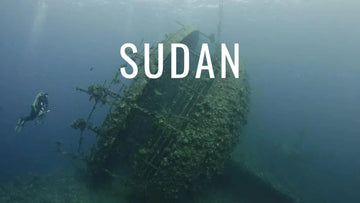Sudan, one of the largest countries in Africa, has relatively little coastline, 65 kilometers, but has excellent dive sites in the most unexplored area of the Red Sea. We could call it "virgin" without any doubt. The great pioneers of diving such as Hans Hass and Jacques Cousteau discovered the richness of its reefs more than 60 years ago and filmed there diving documentaries that have already become classics such as "World Without Sun", "The Silent World" or "Adventures in the Red Sea".
Unlike Egypt, so focused in the diving industry, Sudan and its poor economy has not encouraged the development of these activities, so access to its underwater treasures is more complicated, a fact that otherwise benefits the conservation of its reefs. Divers who choose Sudan as a diving destination will find pristine reefs that hide underwater science fiction stories like Jacques Cousteau's laboratory of Conshelf II, world class wrecks like the Umbria with 5,000 tons of aerial bombs still inside, schools of hammerhead sharks comparable to those of Coco's Island, whale sharks, manta rays and a great variety of extraordinary reef fish. Sudan is virgin territory for the discerning diver.
Diving in Sudan is only possible on liveaboard and can be divided into three main areas: the north, where there is a huge variety of wildlife and known for its reefs full of tropical fish, manta rays, hammerheads and whale sharks; the central region, which offers classic dive sites near Port Sudan such as Umbria or Conshelf II; and the south, where few divers have been and where you can find the largest schools of barracuda and hammerhead sharks.
______________________
The best liveaboard offers in the Red Sea
______________________
Best diving sites in Sudan
Wrecks
The Umbria
The ship's cargo is still intact, it has great visibility, it's easy to dive (not very deep), its history is exciting and you'll feel the stress of knowing you're diving in a wreck with more than 5,000 tons of bombs... That's why it's considered one of the best in the world (some say the best)... The Umbria is big enough to give you a lot to explore, but small enough to cover in a single dive a beautiful wreck with so many details that you won't find anywhere else in the world.
Blue Belt
One of the most interesting aspects of diving in the Blue Belt is its cargo, nearly 200 Toyota cars (in fact, this wreck is also known as the "Toyota Wreck") scattered along the bottom. Diving on this wreck is not easy due to its depth, but it is well worth a visit.
Coral Reefs
Sanganeb Reef
Sanganeb Reef is one of the richest reefs in the Red Sea, where you can find up to six species of sharks and the most outstanding coral gardens in the area. Whether you're a shark fan or just looking for a great variety of reef life, Sanganeb Reef is one of the best dive sites you'll ever visit.
Angarosh Reef
Angarosh Reef, or "Mother of Sharks" in the local language, is a dive site that emerges from the abyss and receives strong currents that also bring a large number of sharks. Gray, Tiger, White Tips... but mostly Hammerheads, huge schools that can reach more than 50 specimens. Angarosh Reef is one of the most appreciated and famous dive sites in Sudan.

Angarosh Reef is synonymous with shark diving. Picture by AlKok
Merlo Reef
Merlo Reef is a pinnacle rising from the depths of the Red Sea, beautifully decorated with hard and soft corals. Besides its beautiful reef fauna, it is visited by large schools of hammerhead sharks.
Abington Reef
Abington Reef is the northernmost reef in Sudan and is often visited by schools of hammerhead sharks. One of the most interesting details of this reef is that in addition to the hammerheads are the huge schools of Carangidae and you will also find a giant anemone full of clownfish.

Sha'ab Rumi crinoids caused great surprise among Cousteau's "World without sun" critics. Picture by david_salvatori
Sha'ab Rumi
Sha'ab Rumi is probably the most famous and most dived reef in Sudan. Both because of its past, where Jacques Cousteau created his Conshelf II experiments and where he shot the movie "World Without Sun", and because of the great sightings of sharks and many reef species that live there, this site deserves a visit.





















